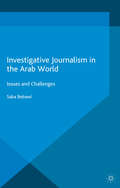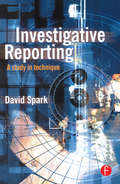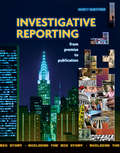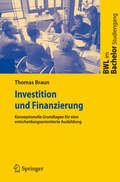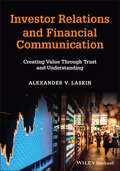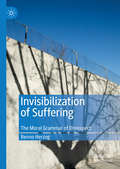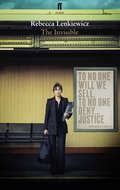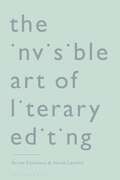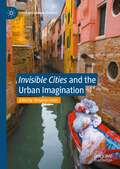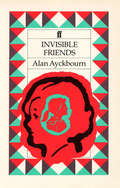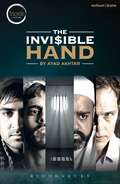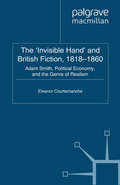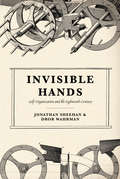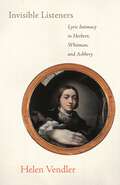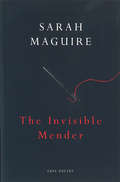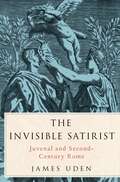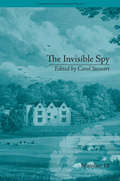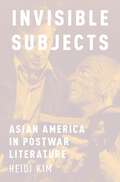- Table View
- List View
Investigative Journalism in the Arab World: Issues and Challenges (Palgrave Studies in Communication for Social Change)
by Saba BebawiThis is the first book that looks into the state and role of investigate journalism in the Arab world. It explores the vital role the media could potentially play in informing and empowering society, to assist in opening up the communicative space in a region where this has previously been taboo.
Investigative Reporting: A study in technique
by David SparkThis important book defines what investigative reporting is and what qualities it requires. Drawing on the experience of many well-known journalists in the field, the author identifies the skills, common factors and special circumstances involved in a wide variety of investigations. It examines how opportunities for investigations can be found and pursued, how informants can be persuaded to yield needed information and how and where this information can be checked. It also stresses the dangers and legal constraints that have to be contended with and shows real life examples such as the Cook Report formula, the Jonathan Aitken investigation and the Birmingham Six story. David Spark, himself a freelance writer of wide experience, examines how opportunities for investigations can be found and pursued, how informants can be persuaded to yield needed information and how and where this information can be checked. He also stresses the dangers and legal constraints that have to be contended with and shows investigators at work in two classic inquiries: · The mysterious weekend spent in Paris by Jonathan Aitken, then Minister of Defence Procurement· The career of masterspy Kim PhilbyInvestigative Reporting looks at such fields for inquiry as company frauds (including those of Robert Maxwell), consumer complaints, crime, police malpractice, the intelligence services, local government and corruption in Parliament and in overseas and international bodies.The author believes that the conclusions that emerge from this far-reaching survey are of value not only in investigative journalism, but to practitioners in all branches of reporting.
Investigative Reporting: A study in technique
by David SparkThis important book defines what investigative reporting is and what qualities it requires. Drawing on the experience of many well-known journalists in the field, the author identifies the skills, common factors and special circumstances involved in a wide variety of investigations. It examines how opportunities for investigations can be found and pursued, how informants can be persuaded to yield needed information and how and where this information can be checked. It also stresses the dangers and legal constraints that have to be contended with and shows real life examples such as the Cook Report formula, the Jonathan Aitken investigation and the Birmingham Six story. David Spark, himself a freelance writer of wide experience, examines how opportunities for investigations can be found and pursued, how informants can be persuaded to yield needed information and how and where this information can be checked. He also stresses the dangers and legal constraints that have to be contended with and shows investigators at work in two classic inquiries: · The mysterious weekend spent in Paris by Jonathan Aitken, then Minister of Defence Procurement· The career of masterspy Kim PhilbyInvestigative Reporting looks at such fields for inquiry as company frauds (including those of Robert Maxwell), consumer complaints, crime, police malpractice, the intelligence services, local government and corruption in Parliament and in overseas and international bodies.The author believes that the conclusions that emerge from this far-reaching survey are of value not only in investigative journalism, but to practitioners in all branches of reporting.
Investigative Reporting from Premise to Publication
by Marcy BurstinerThis book gives readers the confidence they need to handle any investigative reporting assignment and to produce demonstrated results. Its step-by-step progression covering the entire investigative process will help them stay on track to complete stories of any size. The book answers relevant questions such as "Where can I find a story?" "What do I do when a source won't talk?" "How can I find the right documents to support my story?" "How can I present this story online?" and "How can a spreadsheet keep it all from falling apart?" Investigative Reporting contains full stories and timely examples from both professional and student reporters. Each chapter concludes with sequential "Big Story" assignments to help readers research, write and publish their own investigative stories. Web links to online resources (including public records information, computer-assisted reporting techniques and interactive investigative story examples) will help readers move smoothly and successfully through an investigative story or team reporting project, whether for print, broadcast or the Web.
Investigative Reporting from Premise to Publication
by Marcy BurstinerThis book gives readers the confidence they need to handle any investigative reporting assignment and to produce demonstrated results. Its step-by-step progression covering the entire investigative process will help them stay on track to complete stories of any size. The book answers relevant questions such as "Where can I find a story?" "What do I do when a source won't talk?" "How can I find the right documents to support my story?" "How can I present this story online?" and "How can a spreadsheet keep it all from falling apart?" Investigative Reporting contains full stories and timely examples from both professional and student reporters. Each chapter concludes with sequential "Big Story" assignments to help readers research, write and publish their own investigative stories. Web links to online resources (including public records information, computer-assisted reporting techniques and interactive investigative story examples) will help readers move smoothly and successfully through an investigative story or team reporting project, whether for print, broadcast or the Web.
Investition und Finanzierung: Konzeptionelle Grundlagen für eine entscheidungsorientierte Ausbildung (BWL im Bachelor-Studiengang)
by Thomas BraunDas Lehrbuch entspricht der Forderung nach einer praxisorientierten Ausbildung in betriebswirtschaftlichen Bachelor-Studiengängen auf mehreren Wegen: 1. Im Mittelpunkt stehen operationalisierbare Konzepte von universeller Bedeutung. 2. Gängige Formeln werden auf gemeinsame konzeptionelle Grundlagen zurückgeführt, so dass deren Anwendungsbedingungen klar werden. 3. Das Buch fördert die Intuition durch eine einheitliche Notation und reduziert dadurch den erforderlichen Zeitaufwand. Es ist auch für Praktiker zur Auffrischung ihrer Kenntnisse geeignet.
Investor Relations and Financial Communication: Creating Value Through Trust and Understanding
by Alexander V. LaskinEquips students and professionals with the fundamental skills and knowledge needed to succeed in investor relations and financial communication Investor Relations and Financial Communication is a comprehensive, up-to-date introduction to the investor relations and financial communication profession. Written by a leading educator and professional consultant, this authoritative textbook provides the well-rounded foundation necessary for anyone wanting to begin a career as an Investor Relations Officer (IRO). Detailed yet accessible chapters describe all essential aspects of the field, including communication skills, basic financial knowledge, legal and regulatory guidelines, professional standards and practices, and more. Organized in five sections, the book first identifies and defines the jobs available in investor relations and financial communication, detailing the responsibilities, titles, salaries, and key players in the industry. After thoroughly explaining the disclosure of financial and non-financial information, the author describes the regulatory environment in which professionals operate and offers expert insight into issues of corporate governance, environmental sustainability, social responsibility, shareholder activism, and crisis management. Subsequent sections highlight the day-to-day activities of investor relations and financial communication professionals and discuss the future of the field. This invaluable textbook also: Describes the responsibilities of the Investor Relations Officer throughout initial public offering, periodic reporting, and performance evaluation Discusses the role of investor relations professionals in disclosing financial information and educating the investment community Emphasizes the various skills that IROs must possess in order to do their jobs successfully, such as marketing and securities law compliance Includes end-of-chapter review questions, activities, and lists of key terms Investor Relations and Financial Communication: Creating Value Through Trust and Understanding is the perfect textbook for both professional development training programs and undergraduate and graduate courses in investor relations, and is required reading for all those working in investor relations, particularly early-career professionals.
Investor Relations and Financial Communication: Creating Value Through Trust and Understanding (Handbooks In Communication And Media Ser.)
by Alexander V. LaskinEquips students and professionals with the fundamental skills and knowledge needed to succeed in investor relations and financial communication Investor Relations and Financial Communication is a comprehensive, up-to-date introduction to the investor relations and financial communication profession. Written by a leading educator and professional consultant, this authoritative textbook provides the well-rounded foundation necessary for anyone wanting to begin a career as an Investor Relations Officer (IRO). Detailed yet accessible chapters describe all essential aspects of the field, including communication skills, basic financial knowledge, legal and regulatory guidelines, professional standards and practices, and more. Organized in five sections, the book first identifies and defines the jobs available in investor relations and financial communication, detailing the responsibilities, titles, salaries, and key players in the industry. After thoroughly explaining the disclosure of financial and non-financial information, the author describes the regulatory environment in which professionals operate and offers expert insight into issues of corporate governance, environmental sustainability, social responsibility, shareholder activism, and crisis management. Subsequent sections highlight the day-to-day activities of investor relations and financial communication professionals and discuss the future of the field. This invaluable textbook also: Describes the responsibilities of the Investor Relations Officer throughout initial public offering, periodic reporting, and performance evaluation Discusses the role of investor relations professionals in disclosing financial information and educating the investment community Emphasizes the various skills that IROs must possess in order to do their jobs successfully, such as marketing and securities law compliance Includes end-of-chapter review questions, activities, and lists of key terms Investor Relations and Financial Communication: Creating Value Through Trust and Understanding is the perfect textbook for both professional development training programs and undergraduate and graduate courses in investor relations, and is required reading for all those working in investor relations, particularly early-career professionals.
Invisibilization of Suffering: The Moral Grammar of Disrespect
by Benno HerzogThis book offers a comprehensive theory of invisibility as a critical sociological concept, addressing the relationship between social suffering and invisibilization. Herzog draws on social theory and a variety of empirical examples to analyze social grammar and unveil various mechanisms of social suffering. Presenting an original theory of silencing and suffering, this book outlines a substantive theory and methodology of invisibilization as an instrument of authority. This systemic analysis of visibility as both a liberating and dominating mechanism will be a major contribution to the field of critical theory, offering an original framework to help improve the situation of excluded groups and individuals.Invisibilization of Suffering will be an invaluable resource for students and scholars across sociology, social philosophy, social work, political sciences, criminology, linguistics and education, with a focus on justice theory, marginalization, discrimination and exclusion.
The Invisible
by Rebecca LenkiewiczImagine a world where the Stephen Lawrence Case and the Hillsborough Disaster never made it to court. Since 2012 the government has made sweeping cuts to the provision of legal aid. In this new reality, in cases from civil law to immigration, the voices of those seeking justice are in danger of never being heard.The Invisible tells the stories of ordinary people whose access to legal aid has been denied, examining how the cuts are driving ever deeper cracks into the fabric of our society.Rebecca Lenkiewicz's The Invisible was commissioned by the Bush Theatre, London, where it premiered in July 2015.
The Invisible Art of Literary Editing
by Bryan Furuness Sarah LaydenA field guide to the trade and art of editing, this book pulls back the curtain on the day-to-day responsibilities of a literary magazine editor in their role, and to the specific skills necessary to read, mark-up and transform a piece of writing. Combining a break-down of an editor's tasks – including creating a vision, acquisitions, responding to submissions and corresponding with authors – with a behind-the-scenes look at manuscripts in progress, the book rounds up with a test editing section that teaches, by way of engaging exercises, the nitty-gritty strategies and techniques for working on all kinds of texts. Generous in its insight and access to practicing editors' annotations and thought processes, The Invisible Art of Literary Editing offers an exclusive look at nonfiction, fiction and poetry manuscripts as they were first submitted, as they were marked up by an editor and how the final piece was presented before featuring an interview with the editor on the choices they made about that piece of work, as well as their philosophies and working practices in their job. As a skill and a trade learnt through practice and apprenticeship, this is the ultimate companion to editing any piece of work, offering opportunities for learning-by-doing through exercises, reflections and cases studies, and inviting readers to embody the role of an editor to improve their craft and demystify the processes involved in this exciting and highly coveted profession.
The Invisible Art of Literary Editing
by Bryan Furuness Sarah LaydenA field guide to the trade and art of editing, this book pulls back the curtain on the day-to-day responsibilities of a literary magazine editor in their role, and to the specific skills necessary to read, mark-up and transform a piece of writing. Combining a break-down of an editor's tasks – including creating a vision, acquisitions, responding to submissions and corresponding with authors – with a behind-the-scenes look at manuscripts in progress, the book rounds up with a test editing section that teaches, by way of engaging exercises, the nitty-gritty strategies and techniques for working on all kinds of texts. Generous in its insight and access to practicing editors' annotations and thought processes, The Invisible Art of Literary Editing offers an exclusive look at nonfiction, fiction and poetry manuscripts as they were first submitted, as they were marked up by an editor and how the final piece was presented before featuring an interview with the editor on the choices they made about that piece of work, as well as their philosophies and working practices in their job. As a skill and a trade learnt through practice and apprenticeship, this is the ultimate companion to editing any piece of work, offering opportunities for learning-by-doing through exercises, reflections and cases studies, and inviting readers to embody the role of an editor to improve their craft and demystify the processes involved in this exciting and highly coveted profession.
"Invisible Cities" and the Urban Imagination (Literary Urban Studies)
by Benjamin LinderIn 1972, Italo Calvino published Invisible Cities, a literary book that masterfully combines philosophy and poetry, rigid structure and free play, theoretical insight and glittering prose. The text is an extended meditation on urban life, and it continues to resonate not only among literary scholars, but among social scientists, architects, and urban planners as well. To commemorate the 50th anniversary of Invisible Cities, this collection of essays serves as both an appreciation and a critical engagement. Drawing from a wide array of disciplinary perspectives and geographical contexts, this volume grapples with the theoretical, pedagogical, and political legacies of Calvino’s work. Each chapter approaches Invisible Cities not only as a novel but as a work of evocative ethnography, place-writing, and urban theory. Fifty years on, what can Calvino’s dreamlike text offer to scholars and practitioners interested in actually existing urban life?
Invisible Friends: Ernie's Incredible Illucinations, Invisible Friends, This Is Where We Came In, My Very Own Story, The Champion Of Paribanou
by Alan AyckbournAlan Ayckbourn's play is about a very ordinary teenager called Lucy. With her father glued to the cowboys on the telly, her mother preoccupied with neighbourly gossip and her brother enclosed in his ear-phones, no one wants to know about her place in the school swimming team. So Lucy revives her childhood fantasy friend, Zara, setting a place for her at the very ordinary tea table. This time Zara materializes, bringing with her an idealized father and brother, and showing Lucy how to make her real family vanish. The moral of this cautionary tale is carefully spelt out - that when you get what you want it's not what you wanted - as Lucy's dream family turns out to be a nightmare. The play is supposedly for children of seven upwards, but there's a message here for parents, too, about listening to kids.
The Invisible Hand (Modern Plays)
by Ayad AkhtarWe are prisoners of a corrupt country of our own makingAmerican banker Nick Bright knows that his freedom comes at a price. Confined to a cell within the depths of rural Pakistan, every second counts. Who will decide his fate? His captors, or the whims of the market?Pulitzer Prize–winning playwright Ayad Akhtar has written an intense, fast-moving political thriller, which lays bare the raw, unfettered power of global finance.The Invisible Hand received its world premiere at the New York Theatre Workshop on 8 December 2014 and its UK premiere at the Tricycle Theatre, London, on 12 May 2016.
The 'Invisible Hand' and British Fiction, 1818-1860: Adam Smith, Political Economy, and the Genre of Realism (Palgrave Studies in Nineteenth-Century Writing and Culture)
by E. CourtemancheThe 'invisible hand', Adam Smith's metaphor for the morality of capitalism, is explored in this text as being far more subtle and intricate than is usually understood, with many British realist fiction writers (Austen, Dickens, Gaskell, Eliot) having absorbed his model of ironic causality in complex societies and turned it to their own purposes.
Invisible Hands: Self-Organization and the Eighteenth Century
by Jonathan Sheehan Dror WahrmanWhy is the world orderly, and how does this order come to be? Human beings inhabit a multitude of apparently ordered systems—natural, social, political, economic, cognitive, and others—whose origins and purposes are often obscure. In the eighteenth century, older certainties about such orders, rooted in either divine providence or the mechanical operations of nature, began to fall away. In their place arose a new appreciation for the complexity of things, a new recognition of the world’s disorder and randomness, new doubts about simple relations of cause and effect—but with them also a new ability to imagine the world’s orders, whether natural or manmade, as self-organizing. If large systems are left to their own devices, eighteenth-century Europeans increasingly came to believe, order will emerge on its own without any need for external design or direction. In Invisible Hands, Jonathan Sheehan and Dror Wahrman trace the many appearances of the language of self-organization in the eighteenth-century West. Across an array of domains, including religion, society, philosophy, science, politics, economy, and law, they show how and why this way of thinking came into the public view, then grew in prominence and arrived at the threshold of the nineteenth century in versatile, multifarious, and often surprising forms. Offering a new synthesis of intellectual and cultural developments, Invisible Hands is a landmark contribution to the history of the Enlightenment and eighteenth-century culture.
Invisible Listeners: Lyric Intimacy in Herbert, Whitman, and Ashbery
by Helen VendlerWhen a poet addresses a living person--whether friend or enemy, lover or sister--we recognize the expression of intimacy. But what impels poets to leap across time and space to speak to invisible listeners, seeking an ideal intimacy--George Herbert with God, Walt Whitman with a reader in the future, John Ashbery with the Renaissance painter Francesco Parmigianino? In Invisible Listeners, Helen Vendler argues that such poets must invent the language that will enact, on the page, an intimacy they lack in life. Through brilliantly insightful and gracefully written readings of these three great poets over three different centuries, Vendler maps out their relationships with their chosen listeners. For his part, Herbert revises the usual "vertical" address to God in favor of a "horizontal" one-addressing God as a friend. Whitman hovers in a sometimes erotic, sometimes quasi-religious language in conceiving the democratic camerado, who will, following Whitman's example, find his true self. And yet the camerado will be replaced, in Whitman's verse, by the ultimate invisible listener, Death. Ashbery, seeking a fellow artist who believes that art always distorts what it represents, finds he must travel to the remote past. In tones both tender and skeptical he addresses Parmigianino, whose extraordinary self-portrait in a convex mirror furnishes the poet with both a theory and a precedent for his own inventions. By creating the forms and speech of ideal intimacy, these poets set forth the possibility of a more complete and satisfactory human interchange--an ethics of relation that is uncoerced, understanding, and free.
Invisible Listeners: Lyric Intimacy in Herbert, Whitman, and Ashbery
by Helen VendlerWhen a poet addresses a living person--whether friend or enemy, lover or sister--we recognize the expression of intimacy. But what impels poets to leap across time and space to speak to invisible listeners, seeking an ideal intimacy--George Herbert with God, Walt Whitman with a reader in the future, John Ashbery with the Renaissance painter Francesco Parmigianino? In Invisible Listeners, Helen Vendler argues that such poets must invent the language that will enact, on the page, an intimacy they lack in life. Through brilliantly insightful and gracefully written readings of these three great poets over three different centuries, Vendler maps out their relationships with their chosen listeners. For his part, Herbert revises the usual "vertical" address to God in favor of a "horizontal" one-addressing God as a friend. Whitman hovers in a sometimes erotic, sometimes quasi-religious language in conceiving the democratic camerado, who will, following Whitman's example, find his true self. And yet the camerado will be replaced, in Whitman's verse, by the ultimate invisible listener, Death. Ashbery, seeking a fellow artist who believes that art always distorts what it represents, finds he must travel to the remote past. In tones both tender and skeptical he addresses Parmigianino, whose extraordinary self-portrait in a convex mirror furnishes the poet with both a theory and a precedent for his own inventions. By creating the forms and speech of ideal intimacy, these poets set forth the possibility of a more complete and satisfactory human interchange--an ethics of relation that is uncoerced, understanding, and free.
The Invisible Mender
by Sarah MaguireLucid, complex, sensual and richly textured, the poems in The Invisible Mender are notable for the breadth of their subject matter and the precision of their detail. We travel on journeys through landscapes dense with historical and political meanings, from the post-industrial decline of frozen North America to the stymied fecundity of a London garden paralysed in a heatwave: each emotional and physical climate explored and illuminated by the writer's astonishing images and searching intelligence. This is the work of unusual power and frankness, unflinching in its steady examination of grief and love, as in the heartbreaking title poem about the poet's loss of her first mother. But here, and in the magnificent long poem 'The Hearing Cure' this explicit engagement with what is difficult also reveals the redemptive, healing force of language. Sarah Maguire's outstanding first collection of poems, Spilt Milk, was published to considerable critical acclaim and led to her being chosen as one of the New Generation Poets. The Invisible Mender, her eagerly awaited second volume, will confirm her reputation as one of the most exciting young poets in Britain.
The Invisible Satirist: Juvenal and Second-Century Rome
by James UdenThe Invisible Satirist offers a fresh new reading of the Satires of Juvenal, rediscovering the poet as a smart and scathing commentator on the cultural and political world of second-century Rome. Breaking away from the focus in recent scholarship on issues of genre, this study situates Juvenal's Satires within the context of the politics, oratory, and philosophy of Rome under Trajan and Hadrian. In particular, the book shows how Juvenal offers a distinctively Roman response to the Greek sophists and philosophers of the so-called "Second Sophistic." Whereas earlier studies argued for the satirist's adoption of an ironic persona in his poems, this book stresses the absence of any guiding, coherent first-person voice in his work, emphasizing instead the poems' plurality of voices and thematic preoccupation with performance and disguise. These sprawling rhetorical texts, intricately constructed but deliberately lacking any strong personal voice, ultimately communicate a sense of rootlessness and loss of identity-a sense of being invisible-within the cosmopolitan second-century world. The book will appeal to students and scholars of Roman satire, Imperial Roman culture, and Second Sophistic literature.
The Invisible Spy: by Eliza Haywood (Chawton House Library: Women's Novels #18)
by Carol StewartInterest in the work of Eliza Haywood has increased greatly over the last two decades. Though much scholarship is focused on her ‘scandalous’ early career, this critical edition of The Invisible Spy (1755) adds to the canon of her later, more sophisticated work.
The Invisible Spy: by Eliza Haywood (Chawton House Library: Women's Novels)
by Carol StewartInterest in the work of Eliza Haywood has increased greatly over the last two decades. Though much scholarship is focused on her ‘scandalous’ early career, this critical edition of The Invisible Spy (1755) adds to the canon of her later, more sophisticated work.
Invisible Subjects: Asian America in Postwar Literature
by Heidi KimInvisible Subjects broadens the archive of Asian American studies, using advances in Asian American history and historiography to reinterpret the politics of the major figures of post-World War II American literature and criticism. Taking its theoretical inspiration from the work of Ralph Ellison and his focus on the invisibility of a racial minority in mainstream history, Heidi Kim argues that the work of American studies and literature in this era to explain and contain the troubling Asian figure reflects both the swift amnesia that covers the Pacific theater of WWII and the importance of the Asian to immigration debates and civil rights. From the Melville Revival through the myth and symbol school, as well as the fiction of John Steinbeck and William Faulkner, the postwar literary scene exhibits the ambiguity of Asian forms in the 1950s within the binaries of foreigner/native and black/white, as well as the constructs of gender and the nuclear family. It contrasts with the tortured redefinitions of race and nationality that appear in immigration acts and court cases, particularly those about segregation and interracial marriage. The Melville Revival critics' discussion of a mythic and yet realistic diabolical Asian, the role of a Chinese housekeeper in preserving the pioneer family in Steinbeck's East of Eden, and the extent to which the history of the Mississippi Chinese sheds light on Faulkner's stagnant societies all work to subsume a troubling presence. Detailing the archaeology and genealogy of Asian American Studies, Invisible Subjects offers an original, important, and vital contribution to both our understanding of American literary history and the general study of race and ethnicity in American cultural history.
